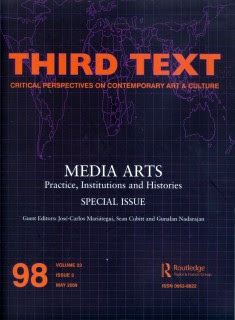Ron Burnett: How Images Think (2005)
Filed under book | Tags: · augmented reality, computer games, electronic art, interactivity, p2p, technology, telepresence, virtual reality

Digital images are an integral part of all media, including television, film, photography, animation, video games, data visualization, and the Internet. In the digital world, spectators become navigators wending their way through a variety of interactive experiences, and images become spaces of visualization with more and more intelligence programmed into the very fabric of communication processes. In How Images Think, Ron Burnett explores this new ecology, which has transformed the relationships humans have with the image-based technologies they have created. So much intelligence has been programmed into these image-dependent technologies that it often seems as if images are “thinking”; ascribing thought to machines redefines our relationship with them and enlarges our ideas about body and mind. Burnett argues that the development of this new, closely interdependent relationship marks a turning point in our understanding of the connections between humans and machines.
After presenting an overview of visual perception, Burnett examines the interactive modes of new technologies—including computer games, virtual reality, digital photography, and film— and locates digital images in a historical context. He argues that virtual images occupy a “middle space,” combining the virtual and the real into an environment of visualization that blurs the distinctions between subject and object—part of a continuum of experiences generated by creative choices by viewers, the results of which cannot be attributed either to images or to participants.
Publisher MIT Press, 2005
ISBN 0262524414, 9780262524414
Length 253 pages
More info (publisher)
More info (google books)
Third Text, 98: Media Arts: Practice, Institutions and Histories (2009)
Filed under journal | Tags: · art, electronic art, media art, postcolonialism, video art, visual culture

Special issue of Third Text journal is an update on the development and current state of new media arts in some “under-represented” regions and contexts of the world, from New Zealand to India and from South Africa to the former East of Europe.
Guest Editors: Sean Cubitt, Jose-Carlos Mariategui and Gunalan Nadarajan.
Contributions by Nina Czegledy and Andrea Szekeres, Olga Goriunova, Pi Li, Marcus Neustetter, Ravi Sundaram and others.
Publisher Third Text, May 2009
ISSN: 1475-5297 (electronic) 0952-8822 (paper)
PDF (updated on 2016-4-16)
Comments (2)Roy Ascott (ed.): Reframing Consciousness: Art, Mind and Technology (1999)
Filed under book | Tags: · art, chaos theory, consciousness, cyberspace, electronic art, hypermedia, interface, memory, science, technology, telematics, telepresence, virtual reality

We are in the middle of a process of complex cultural transformation, but to what extent is this matched by the transformation in the way we see ourselves? This book covers a wide-ranging discussion on the interaction between Art, Science and Technology, and goes on to challenge assumptions about ‘reality’.
Loosely themed around four key elements of Mind, Body, Art and Values, the editor leads the investigation through the familiar territories of interactive media and artificial life, combining them with new and ancient ideas about creativity and personal identity.The contributing authors number over sixty highly respected practitioners and theorists in art and science, bringing to the subject a stimulating diversity of approach and a rich background of knowledge.
Art has long been preoccupied with questions involving the mind and consciousness. But it is fast finding that new technology, creatively applied, brings new possibilities to bear. This volume provides a strong foundation for the debates that are sure to follow in this field.
Publisher Intellect Books, 1999
ISBN 1841500135, 9781841500133
314 pages
PDF (updated on 2012-7-24)
Comment (0)
